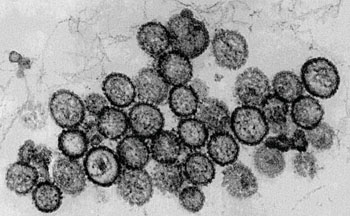Potential Biomarker Found for Severe Viral Hemorrhagic Fevers
By LabMedica International staff writers
Posted on 20 Jul 2016
Hemorrhagic fever with renal syndrome (HFRS) and Crimean-Congo hemorrhagic fever (CCHF) are common representatives of viral hemorrhagic fevers still often neglected in some parts of the world.Posted on 20 Jul 2016
Infection with Dobrava or Puumala virus (HFRS) and Crimean-Congo hemorrhagic fever virus (CCHFV) can result in a mild, nonspecific febrile illness or as a severe disease with hemorrhaging and high fatality rate. An important factor in optimizing survival rate in patients with VHF is instant recognition of the severe form of the disease for which significant biomarkers need to be elucidated.

Image: A scanning electron micrograph (SEM) of Puumala virus, a species of hantavirus (Photo courtesy of Hans R. Gelderblom, Freya Kaulbars/RKI).
Medical faculty members of the University of Ljubljana (Ljubljana, Slovenia) examined 128 serum samples of patients with hemorrhagic fever, HFRS patients were hospitalized in different Slovenian hospitals and clinical diagnosis was confirmed with serological or molecular tests. From 72 HFRS patients included in the study, 24 were infected with Dobrava virus (DOBV) and 48 were infected with Puumala virus (PUUV). Additionally, they analyzed 29 serial samples from seven HFRS patients. Fifty-six patients from Kosovo with confirmed CCHF were also included in the study.
The scientists we investigated the role of High Mobility Group Box 1 (HMGB1) or amphoterin as a prognostic marker for the severe form of HFRS and CCHF. The concentration of HMGB1 was measured with commercially available HMGB1 capture enzyme-linked immunosorbent assay (ELISA) kit (Chondrex, Redmond, WA, USA) and samples were measured in duplicate. For each patient a detailed medical chart was collected and significant laboratory parameters were analyzed. Additionally, serum samples of 61 healthy donors were tested and processed as patients’ samples.
The investigators found that HMGB1 levels were increased in patients with CCHFV, DOBV or PUUV infection. More importantly, concentration of HMGB1were higher in patients with severe disease progression when compared to the mild clinical course of the disease. The results indicate that HMGB1 could be a useful prognostic biomarker for disease severity in PUUV and CCHFV infection, where the difference between the mild and severe patients group was highly significant and even in patients with severe DOBV infection concentrations of HMGB1 were 2.8–times higher than in the mild group. The study was published on June 27, 2016, in the journal Public Library of Science Neglected tropical Diseases.
Related Links:
University of Ljubljana
Chondrex














